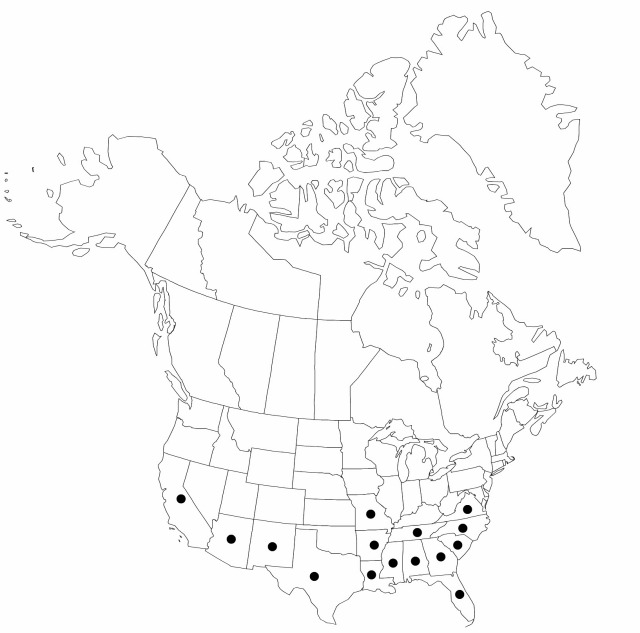Cyperus rotundus
Sp. Pl. 1: 45. 1753.
Herbs, perennial, stoloniferous; stolons (2–) 5–12 cm × 1–2 mm, bearing tubers 3–8 (–12) mm diam., wiry, springy when dried, indurate. Culms trigonous, 10–35 (–40) cm × 0.7–3.4 mm, basally indurate, glabrous. Leaves V-shaped to flanged V-shaped, 5–30 cm × 2–6 mm. Inflorescences: spikes 1 (–3), broadly ellipsoid, (12–) 15–25 (–30) × (12–) 20–30 (–50) mm, rays (3–) 4–6 (–7), 0.2–10 cm;, bracts (2–) 3–5, horizontal to ascending at 45°, V-shaped to flanged V-shaped, 0.5–10 cm × 0.5–4 mm, rachilla persistent, wings 0.5–1 mm wide. Spikelets (2–) 3–7 (–12), compressed, linear, 4–40 × 1.3–1.8 mm, floral scales persistent, 6–36 (–42), spreading or appressed, purple to reddish-brown, with narrow clear border and green midrib, 7–9-ribbed, ovate, (1.8–) 2.6–3.4 × 2.2–3 mm, apex obtuse. Flowers: anthers 1–2.5 mm, styles 1.3–3.5 mm, stigmas (1.8–) 2–3.3 mm. Achenes black, sessile, ellipsoid, abaxial face convex, adaxial face concave, 1.4–1.7 (–1.9) × 0.8–1 mm, apex obtuse, surfaces puncticulate.
Phenology: Fruiting summer–fall.
Habitat: Croplands, disturbed soils usually
Elevation: 0–400 m
Distribution

Ala., Ariz., Ark., Calif., Fla., Ga., La., Miss., Mo., N.Mex., N.C., S.C., Tenn., Tex., Va., Mexico, Central America, South America, Asia, Africa, Australia
Discussion
Cyperus rotundus is documented in Connecticut, Delaware, New York, and Pennsylvania; there is no evidence of persistent populations.
Cyperus esculentus and C. rotundus are the only two species of subg. Cyperus in the New World that produce tuberiferous stolons. The two species also have persistent floral scales and persistent rachillas, a combination of characteristics not found in any other New World species of Cyperus.
Cyperus rotundus is distinguished from other species of the genus in the New World by its open spikes composed of linear reddish spikelets borne on a conspicuous slender rachis. Cyperus rotundus is usually acknowledged to be the world’s worst weed (cf. G. C. Tucker 1987). In the United States, it does not grow north of the mean 1°C January isotherm. Cyperus esculentus (preceding species) is a serious weed in much of the world, especially in cooler regions where the more tropical C. rotundus does not grow. Cyperus esculentus is able to tolerate lower air temperatures (as low as -18°C). The two species apparently differ also in their thermal optima for growth.
Selected References
None.
Lower Taxa
"shortened" is not a number.
